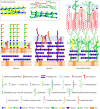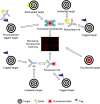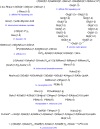Microarray Strategies for Exploring Bacterial Surface Glycans and Their Interactions With Glycan-Binding Proteins
- PMID: 32010066
- PMCID: PMC6972965
- DOI: 10.3389/fmicb.2019.02909
Microarray Strategies for Exploring Bacterial Surface Glycans and Their Interactions With Glycan-Binding Proteins
Abstract
Bacterial surfaces are decorated with distinct carbohydrate structures that may substantially differ among species and strains. These structures can be recognized by a variety of glycan-binding proteins, playing an important role in the bacteria cross-talk with the host and invading bacteriophages, and also in the formation of bacterial microcolonies and biofilms. In recent years, different microarray approaches for exploring bacterial surface glycans and their recognition by proteins have been developed. A main advantage of the microarray format is the inherent miniaturization of the method, which allows sensitive and high-throughput analyses with very small amounts of sample. Antibody and lectin microarrays have been used for examining bacterial glycosignatures, enabling bacteria identification and differentiation among strains. In addition, microarrays incorporating bacterial carbohydrate structures have served to evaluate their recognition by diverse host/phage/bacterial glycan-binding proteins, such as lectins, effectors of the immune system, or bacterial and phagic cell wall lysins, and to identify antigenic determinants for vaccine development. The list of samples printed in the arrays includes polysaccharides, lipopoly/lipooligosaccharides, (lipo)teichoic acids, and peptidoglycans, as well as sequence-defined oligosaccharide fragments. Moreover, microarrays of cell wall fragments and entire bacterial cells have been developed, which also allow to study bacterial glycosylation patterns. In this review, examples of the different microarray platforms and applications are presented with a view to give the current state-of-the-art and future prospects in this field.
Keywords: antibodies; bacterial glycans; bacterial interactions; immune system; lectins; microarrays; vaccine development.
Copyright © 2020 Campanero-Rhodes, Palma, Menéndez and Solís.
Figures






Similar articles
-
Bacterial Microarrays for Examining Bacterial Glycosignatures and Recognition by Host Lectins.Methods Mol Biol. 2022;2460:147-160. doi: 10.1007/978-1-0716-2148-6_9. Methods Mol Biol. 2022. PMID: 34972935
-
Bacterial Surface Glycans: Microarray and QCM Strategies for Glycophenotyping and Exploration of Recognition by Host Receptors.Methods Enzymol. 2018;598:37-70. doi: 10.1016/bs.mie.2017.06.011. Epub 2017 Aug 10. Methods Enzymol. 2018. PMID: 29306443
-
Investigation of Group A Streptococcal Interactions with Host Glycan Structures Using High-Throughput Techniques: Glycan Microarray Analysis Using Recombinant Protein and Whole Cells.Methods Mol Biol. 2020;2136:145-151. doi: 10.1007/978-1-0716-0467-0_10. Methods Mol Biol. 2020. PMID: 32430818
-
Assessing Bacterial Interactions Using Carbohydrate-Based Microarrays.Microarrays (Basel). 2015 Dec 10;4(4):690-713. doi: 10.3390/microarrays4040690. Microarrays (Basel). 2015. PMID: 27600247 Free PMC article. Review.
-
Microarrays in glycoproteomics research.Clin Lab Med. 2009 Mar;29(1):15-29. doi: 10.1016/j.cll.2009.01.001. Clin Lab Med. 2009. PMID: 19389548 Free PMC article. Review.
Cited by
-
Chemical Reporters for Bacterial Glycans: Development and Applications.Chem Rev. 2022 Feb 9;122(3):3336-3413. doi: 10.1021/acs.chemrev.1c00729. Epub 2021 Dec 14. Chem Rev. 2022. PMID: 34905344 Free PMC article. Review.
-
Lactobacillus, glycans and drivers of health in the vaginal microbiome.Microbiome Res Rep. 2022 May 13;1(3):18. doi: 10.20517/mrr.2022.03. eCollection 2022. Microbiome Res Rep. 2022. PMID: 38046360 Free PMC article.
-
Chemical tools to study and modulate glycan-mediated host-bacteria interactions.Curr Opin Chem Biol. 2025 Aug;87:102603. doi: 10.1016/j.cbpa.2025.102603. Epub 2025 Jun 4. Curr Opin Chem Biol. 2025. PMID: 40472591 Review.
-
Sweet impersonators: Molecular mimicry of host glycans by bacteria.Glycobiology. 2022 Feb 26;32(1):11-22. doi: 10.1093/glycob/cwab104. Glycobiology. 2022. PMID: 34939094 Free PMC article. Review.
-
Long-term TCDD oral exposure changes gut microbial glycosylation patterns in female but not male C57BL/6 mice.Arch Toxicol. 2025 Aug 6. doi: 10.1007/s00204-025-04137-6. Online ahead of print. Arch Toxicol. 2025. PMID: 40770081
References
-
- Blanco Y., Prieto-Ballesteros O., Gómez M. J., Moreno-Paz M., García-Villadangos M., Rodríguez-Manfredi J. A., et al. (2012). Prokaryotic communities and operating metabolisms in the surface and the permafrost of Deception Island (Antarctica). Environ. Microbiol. 14 2495–2510. 10.1111/j.1462-2920.2012.02767.x - DOI - PubMed
Publication types
LinkOut - more resources
Full Text Sources
Other Literature Sources

